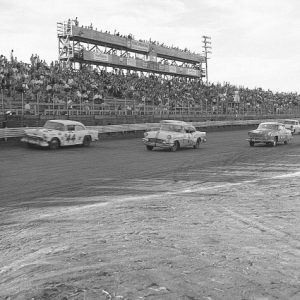calsfoundation@cals.org
Memphis-Arkansas Speedway
During a four-year span in the 1950s, the Memphis-Arkansas Speedway located near Lehi (Crittenden County) was the longest racetrack and one of the fastest racetracks on the NASCAR circuit. Only Darlington Speedway in South Carolina and the beach course in Daytona, Florida, saw speeds exceeding the Arkansas speedway’s. In the twenty-first century, approximately a third of premier NASCAR races are run on 1.5 mile, oval tracks; the Memphis-Arkansas Speedway was the first of this kind of track.
The paper clip–shaped track, one and half miles in length, was made up of 550-foot-radius, high-banked turns, connected by 2,500-foot straights. “I remember going there a long time ago. We raced there in the summer and I went with Daddy,” said seven-time NASCAR champion Richard Petty, son of NASCAR champion Lee Petty, about his racing adventures with his father. “The track had a lot of banking, and I remember that they had two ponds on both ends of the speedway. They used that dirt for the banking.”
The track opened in 1954, when fifty-two cars took the green flag for the track’s first NASCAR Grand National race, the Mid-South 250. Lee Petty dominated the race before being sidelined by a broken axle just seventeen laps from the finish. Buck Baker collected the win, five laps ahead of runner-up Dick Rathman, while Petty finished third.
The following year’s Mid-South 250 was rained out twice before being held on August 14, 1955. All 167 laps were led by either Tim Flock or his brother Fonty, who won the race in a 1955 Chrysler with an average speed of 89.982 mph in front of a reported crowd of 15,000. NASCAR would return that same year to run a 300-mile Grand National race. Speedy Thompson led 158 laps in a 1955 Ford to win and collect $2,900. This race also saw the track’s record-setting qualifying speed of 100.39 miles per hour.
Tragedy struck on both days of the third annual Grand National event in 1956. On Saturday, June 9, Clint McHugh, age twenty-eight of Biloxi, Mississippi, was killed during a qualifying lap when his Oldsmobile, while running over 90 mph, swerved and flipped over a three-foot guard rail, landing in the lake fifty feet below the banking of turn three. During the race the following day, Thomas “Cotton” Priddy, age twenty-seven of Louisville, Kentucky, was thrown from his 1956 Chevrolet on lap thirty-nine in an end-over-end crash in turn one. He died of his injuries shortly after. Ralph Moody, of Holman-Moody racing/race-car fame, won that day but only after protesting the win originally awarded to Jim Paschal; the margin of victory was four seconds.
Marvin Panch won the track’s final race on July 14, 1957.
The dirt track surface proved unmanageable due to the abuse from heavy race cars, often resulting in extended caution periods to allow the blinding dust storm to dissipate. Track owners Clarence Camp, Harold Woolridge, and Nat Epstein could not raise the $100,000 needed to pave the track. The owners sold the land to farmer Clayton Eubanks Sr. in 1958. Initially, catfish were raised in the flooded infield, and then the track was leveled and the land used to grow rice and soybeans. Speaking of its location, resident Parker Eubanks stated, “If the interstate would have been complete, it’s only a mile from Lehi to the off-ramp. They could have gotten onto the interstate and it would have been great.”
For additional information:
“Memphis-Arkansas Speedway.” Racing-Reference.info. http://racing-reference.info/tracks?id=011 (accessed February 1, 2018).
“Racing History Minute—August 14, 1955.” Racers Reunion. http://racersreunion.com/community/forum/stock-car-racing-history/37235/racing-history-minute-august-14-1955 (accessed February 1, 2018).
Todd Lambert
Bismarck, Arkansas
 World War II through the Faubus Era, 1941 through 1967
World War II through the Faubus Era, 1941 through 1967 Memphis-Arkansas Speedway
Memphis-Arkansas Speedway 




Comments
No comments on this entry yet.